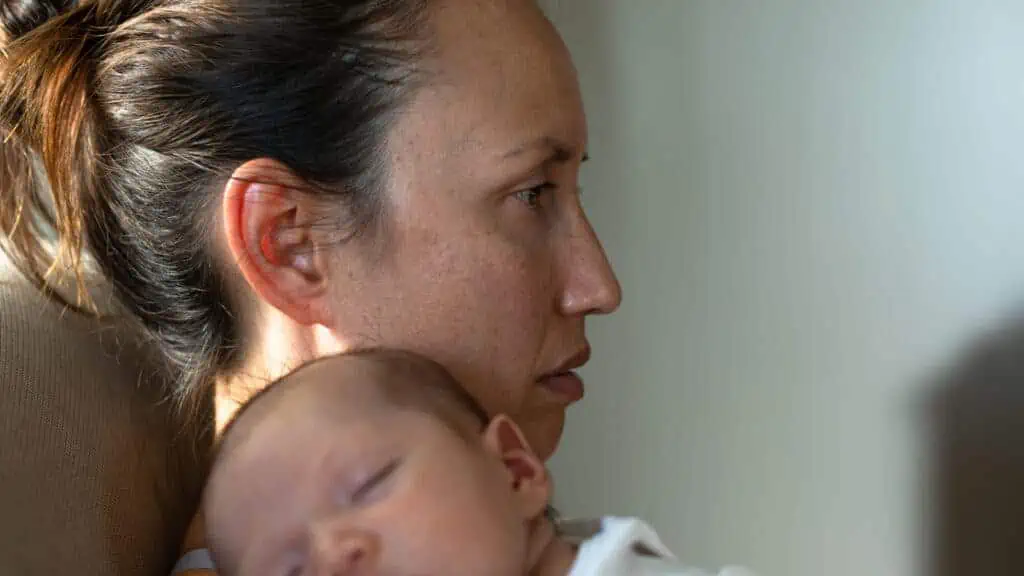Postpartum Preeclampsia: Warning Signs Moms Should Know About
This post may contain affiliate links. As an Amazon Associate, I earn from qualifying purchases.
A woman can develop high blood pressure at any time. But it can lead to grave complications if it begins during her pregnancy or right after she gives birth (postpartum preeclampsia). The early postpartum period (from delivery up to seven days afterward) is when women who experience postpartum preeclampsia are at the highest risk – much of this risk can be lessened with adequate blood pressure control.
Read on to learn to recognize the warning signs of postpartum preeclampsia.
What is postpartum preeclampsia?
Postpartum preeclampsia is a severe hypertensive disorder that can occur after childbirth. It simply means you have elevated blood pressure above 140/90 mmHg and high protein levels in your urine.
Early postpartum preeclampsia develops within the first few days or weeks after delivery. But, it can sometimes progress up to six weeks or later after childbirth. This is known as late postpartum preeclampsia.
Women who develop preeclampsia during pregnancy or have pre-existing hypertension are at a higher risk for developing postpartum preeclampsia. One study found that slightly more than one-half of women who had postpartum preeclampsia did not have preeclampsia before or in a previous pregnancy.
It is necessary to recognize and treat postpartum preeclampsia because the risk of complications may be higher than if the conditions had occurred during pregnancy. Postpartum preeclampsia can progress very quickly if not treated and may lead to stroke or death.
Related read: The Complete Postpartum Care Checklist

What is the difference between preeclampsia and postpartum preeclampsia?
Both preeclampsia and postpartum preeclampsia are hypertensive disorders related to pregnancy. They are similar in their symptoms, risk factors, and how they are treated. One difference is the timing of when it occurs.
A pregnant woman can develop preeclampsia during pregnancy, while postpartum preeclampsia only happens after her baby is born.
Some moms who have normal blood pressure can get postpartum preeclampsia. It is also possible this condition begins during pregnancy but does not show signs or symptoms until your baby arrives.
Warning signs of postpartum preeclampsia
Essentially postpartum preeclampsia can be challenging to detect on your own sometimes. You might not suspect anything is wrong because your focus is on recovering after childbirth and caring for your newborn.
Though postpartum preeclampsia is a rare medical condition, it is also dangerous and may be life-threatening. Learning to recognize its symptoms could literally save your life. The symptoms include:
- Uncontrolled high blood pressure
- Severe headaches and light sensitivity pain
- Upper right abdominal pain
- Unusual swelling of the hands and face
- Rapid weight gain
- Shortness of breath
- Nausea or vomiting
- Decreased urine output

How does postpartum preeclampsia develop?
No one knows the exact cause of postpartum preeclampsia, but certain factors may increase your risk. Some of the factors for postpartum preeclampsia include:
- Poorly controlled hypertension before you were pregnant
- High blood pressure during your most recent pregnancy (gestational hypertension)
- A family history of postpartum preeclampsia
- Being under age 20 or over age 40 when you have your first baby
- Sudden weight gain
- Having multiple pregnancies, such as twins or triplets
- Having type 1, type 2, or gestational diabetes
- Autoimmune disorders
- Kidney disease
- Genetic factors
- Problem with blood vessels

How is postpartum preeclampsia diagnosed?
Your doctor will keep tabs on you if you recently gave birth and immediately suspects you are at risk of developing postpartum preeclampsia. They may order a series of tests to confirm the diagnosis when necessary.
Blood pressure measurement
Blood pressure readings consistently above 140/90 mmHg may indicate postpartum hypertension.
Urine tests
A urine sample checks for proteinuria – the presence of excess protein in your urine.
Blood tests
A blood test checks for abnormalities in liver function and platelet count.
Imaging tests
In some cases, imaging tests such as ultrasound assesses the function of organs such as the kidneys or liver. A brain scan can also look for possible brain damage if you have had a seizure.
You may need to be admitted to the hospital for further monitoring and treatment where necessary.

How to treat postpartum preeclampsia
If you have signs or symptoms of postpartum preeclampsia shortly after childbirth, contact your healthcare provider for immediate medical care. Complications like stroke, seizures, and organ damage occur if treatment of postpartum preeclampsia does not commence early.
Treating this condition will involve monitoring your blood pressure closely, other vital signs, and the medications prescribed, especially for a breastfeeding mother. Thankfully, high blood pressure medications have no or minimal risk to babies. In some cases, hospitalization may be necessary.
Some of the medications used in treating postpartum preeclampsia include:
Antihypertensive medications
These are medications that lower your blood pressure. Examples include labetalol, nifedipine, and hydralazine.
Magnesium sulfate
This medication prevents seizures.
Diuretics
These medications help reduce fluid buildup through urination and decrease blood pressure.
Related read: What Medicine Can I Take While Breastfeeding?
Complications of postpartum preeclampsia
Postpartum preeclampsia can permanently damage vital organs and lead to life-threatening complications if the symptoms are not noticed early and treated. Some of these are:
- Blood clots deprive blood supply to the brain tissue causing a stroke
- Excess fluid develops in the lungs (pulmonary edema)
- Damage to the brain resulting in seizures
- HELLP syndrome is short for hemolysis (destruction of red blood cells), elevated liver enzymes, and low platelet count.
The outlook for full recovery is good once the diagnosis and treatment begin.
How to prevent postpartum preeclampsia
It is actually confusing to prevent a condition with an unknown cause. So technically, there is no way to prevent postpartum preeclampsia. However, if you have chronic high blood pressure before or develop one after giving birth, you may need close monitoring. Your doctor will review and recommend meds to control it to prevent serious complications that could arise from the condition.
You can also do your part by learning the symptoms of postpartum preeclampsia to spot them on time. This is the best way to prevent any complications associated with the condition.
Related read: 23 Postpartum Recovery Tips To Heal Faster From Birth.

Conclusion
The postpartum period is always an exciting time for you to bond with your baby. But amid all the excitement, stay vigilant for symptoms of postpartum preeclampsia and check your blood pressure regularly.
Remember to seek immediate medical care if you feel something is wrong. By working closely with your healthcare providers and taking steps to manage risk factors, you can reduce your likelihood of developing complications of postpartum preeclampsia.
Did you experience similar signs after giving birth? Does high blood pressure run in your family? Please leave a comment to share.







